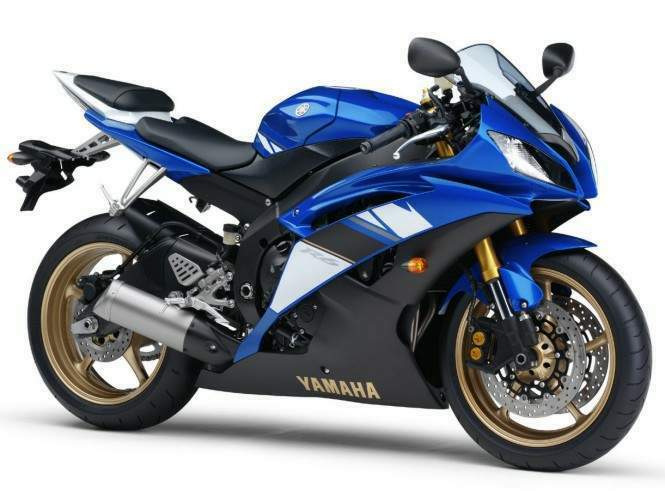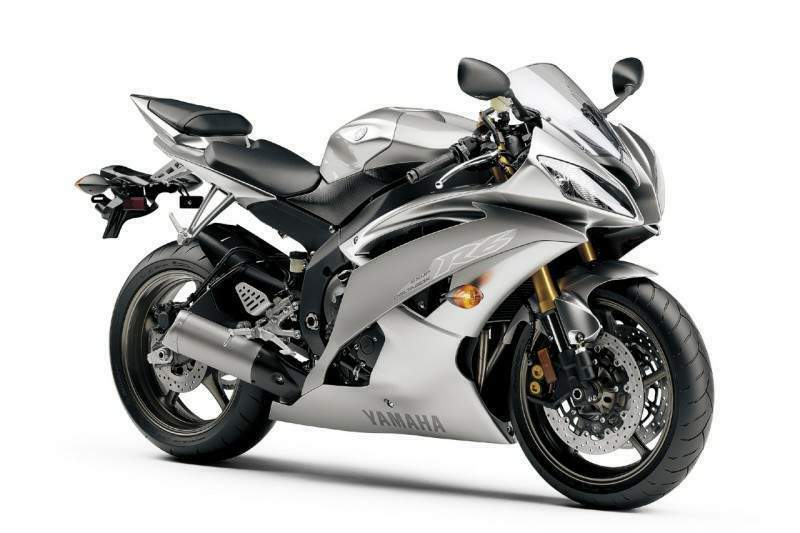2008 R6 Raven Edition
Yamaha YZF-600R6
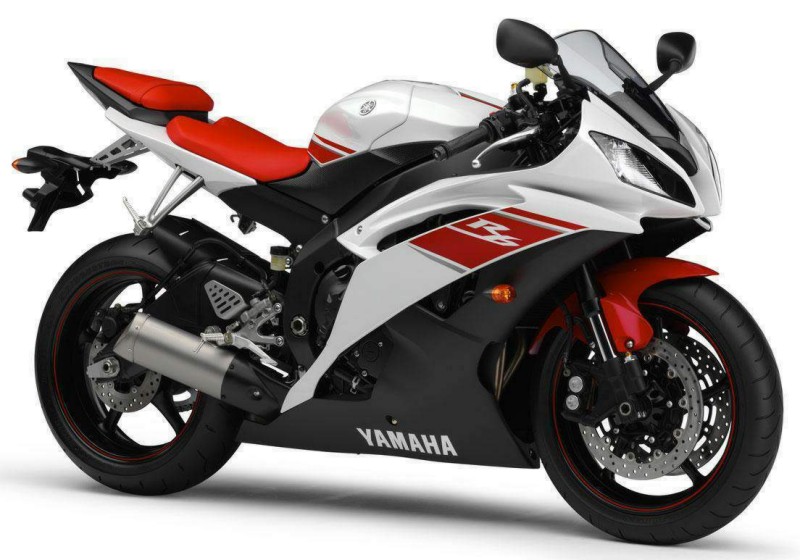
| Make Model | Yamaha YZF 600 R6 |
| Year | 2008 |
| Engine | Four stroke, transverse four cylinder, DOHC, 4 valves per cylinder. |
| Capacity | 599 cc / 36.5 cu-in |
| Bore x Stroke | 67 x 42.5 mm |
| Compression Ratio | 13.1;1 |
| Cooling System | Liquid cooled |
| Lubrication | Wet sump |
| Oil Capacity | 3.4 Litres |
| Engine Oil | 10W/30 |
| Induction | 41 mm Mikuni throttle body F.I. |
| Ignition | TCI |
| Spark Plug | NGK, CR10EK |
| Starting | Electric |
| Max Power | 94.9 kW / 129 hp @ 14500 rpm |
| Max Power Ram Air | 99.6 kW / 135 hp @ 14500 rpm |
| Max Torque | 65.8 Nm / 6.71 kgf-m @ 11000 rpm |
| Max Torque Ram Air | 69.1 Nm / 7.05 kgf-m @ 11000 rpm |
| Clutch | Wet, slipper, cable operated |
| Transmission | 6 Speed |
| Final Drive | O-ring chain |
| Gear Ratio | 1st 31/12 (2.583) / 2nd 32/16 (2.000) / 3rd 30/18 (1.667) / 4th 26/18 (1.444) / 5th 27/21 (1.286) / 6th 23/20 (1.150) |
| Frame | Deltabox aluminium frame with revised rigidity balance |
| Front Suspension | Fully adjustable 41 mm inverted cartridge fork, |
| Front Wheel Travel | 119.4 mm / 4.7 in |
| Rear Suspension | Fully adjustable link Monocross; 4-way adjustable, |
| Rear Wheel Travel | 119.4 mm / 4.7 in |
| Front Brakes | 2x 310mm discs 4 piston calipers |
| Rear Brakes | Single 220mm disc 1 piston caliper |
| Front Tyre | 120/70 ZR17 |
| Rear Tyre | 180/55 ZR17 |
| Dimensions | Length 2040mm / 80.3in Width 705mm / 27.8'in Height 1095mm / 43.1in |
| Wheelbase | 1375 mm / 54.1 in |
| Rake | 24� |
| Trail | 97mm / 3.8 in |
| Ground Clearance | 130 mm / 5.1 in |
| Seat Height | 850 mm / 33.5 in |
| Dry Weight | 166 kg / 366 lbs |
| Wet Weight | 188 kg / 413.6 lb |
| Fuel Capacity | 17.5 Liters / 3.7 gal |
| Consumption Average | 19.3 km/lit |
| Standing � Mile | 11.6 sec |
| Top Speed | 256.9 km/h |
This model adopts Yamaha�s new �YCC-I� electronic control intake, which has been developed under Yamaha�s G.E.N.I.C.H. engineering ideal using exclusive electronic control technologies and is now put to practical use to boost engine performance. Another new feature is the lightweight magnesium rear frame made possible by a unique Yamaha technology and adopted for the first time ever on a production motorcycle. By contributing to greater concentration of mass it helps realize the next level of sport riding performance.
The 2006 model YZF-R6 featured a high-performance engine adopting for the first time the �YCC-T� (Yamaha Chip Controlled Throttle) based on Yamaha�s G.E.N.I.C.H. engineering ideal and was released as �the extreme supersport fastest on the circuit.� Ever since, it has won great popularity on the European and North American 600cc supersport markets. The reasons for its popularity are its acceleration in the over 10,000 rpm range, smooth power development and response, light, agile cornering, smooth operability and unique styling. At the same time, as the market has expanded, there have been many calls for even higher levels of running performance while maintaining the same original model concept.
In light of this market background, the new YZF-R6 has been developed around the new concept of �an R6 that is No. 1 in laser-sharp handling and super-exciting performance.� Under this concept, the existing circuit performance and performance on secondary and winding roads has been supplemented by (1) added excitement in circuit riding, (2) handling that lets the rider enjoy quicker banking and turning and more agile exiting of turns and (3) new developments in original styling that maintains the YZF-R6 identity. This model also adopts new technologies for greater product maturity, including Yamaha�s new �YCC-I� electronic control intake and the first lightweight magnesium rear frame ever adopted on a production motorcycle. These features further boost running performance.
Key Features:
- Light, powerful and bristling with knowledge gained from years of racing, the YZF-R6 is the most advanced production 600cc motorcycle Yamaha�or anybody else�has ever built.
- The YZF-R6 was the first production motorcycle with a fly-by-wire throttle system�for flawless response under all conditions.
- YCC-I, Yamaha Chip Controlled Intake, introduced in 2007 on the R1, is now used on the R6 to vary intake tract length for excellent cylinder filling and a broader powerband. On the higher-revving R6, its benefits are even more pronounced.
- Slipper-type back torque-limiting clutch greatly facilitates braking/downshifting from high speed.
New for 2008
- Over 50 friction-reducing strategies have been employed inside the engine, including the use of wider crank bearings.
- Upgraded fuel injection mapping for the YCC-T dual-injector system complements the higher compression ratio for great throttle response and reduced engine braking.
- A magnesium subframe removes weight from the rear of the motorcycle for increased mass centralization.
- All-new frame takes handling to the next level, allowing more precise turn-in, greater corner speed, and tighter exits. Thicker headpipe-headstock and swingarm pivot area walls, and elimination of the frame crossmember, help achieve perfect balance.
- New swingarm has internal ribs added, and extruded section is now forged to work with the new frame.
- Revised outer fork tubes, a new lower triple clamp, and increased fork offset provide highly tactile front-end feedback.
- Moving the rider and bars forward and slightly lower enhances braking and turn-in performance. Clip-ons are also lower and re-angled.
- Front discs are 310 x 5mm instead of 4.5mm for increased cooling qualities.
- Increased fork height adjustability and rear ride-height adjustment range accommodate a greater range of riders and tires.
- Revised bodywork results in even greater aerodynamic efficiency.
Engine:
- YCCT�Yamaha Chip Controlled Throttle�uses a powerful ECU and multiple sensors to provide perfect, smooth engine response and optimal power whenever the throttle is twisted under all conditions.
- Twin-injector fuel injection: shower-type injectors above each intake funnel help achieve optimum fuel atomization at high rpm.
- Back torque-limiting slipper clutch greatly facilitates braking and downshifting from high speed. Close-ratio six-speed transmission delivers seamless power and maximum acceleration.
- GP-style titanium muffler contributes to mass centralization and contains EXUP for a broad powerband, spot-on injection and emissions compliance.
- Linerless, direct-plated ceramic-composite cylinder bores mean greater heat dissipation for consistent power delivery and reduced friction.
- Cool magnesium valve and engine covers are light and stylish.
- Direct-ignition coils, dual-electrode spark plugs and high-output magneto deliver extremely accurate, reliable firing.
SUSPENSION:
- Deltabox aluminum frame incorporates GP thinking in terms of engine positioning and rigidity for the ultimate in 600-class handling.
- Light, Controlled-Fill swingarm pivots high in the frame, for increased anti-squat effect and mid-corner stability. TZ-type chain adjusters ease rear tire changes.
- Four-way adjustable (preload, high-speed compression, low-speed compression and rebound damping) inverted fork with 41mm tubes increases freedom in setting up for street or track use; soak up the bumps and resist bottoming when braking.
- Four-way adjustable (preload, high-speed compression, low-speed compression and rebound damping) piggyback rear shock delivers exceptional rear wheel tracking and stability.
- Dual 310mm front disc brakes use forged one-piece radial-mount calipers and radial-pump front master cylinder with adjustable lever for astounding braking power and feel.
- The casting technique for the five-spoke 17-inch wheels makes the rims light and strong, not to mention wickedly cool-looking.
Additional Features:
- Quick-detach license plate holder and rear turn signal mount makes prepping for track days or racing a snap.
- Built-in lap timer is controlled by a right handlebar switch.
- Multifunction digital and analog instrumentation features: programmable shift light, digital speedometer, analog tachometer, dual tripmeters with miles-on-reserve function, odometer, water temp gauge and lights for neutral, high beam, low fuel and turn signals.
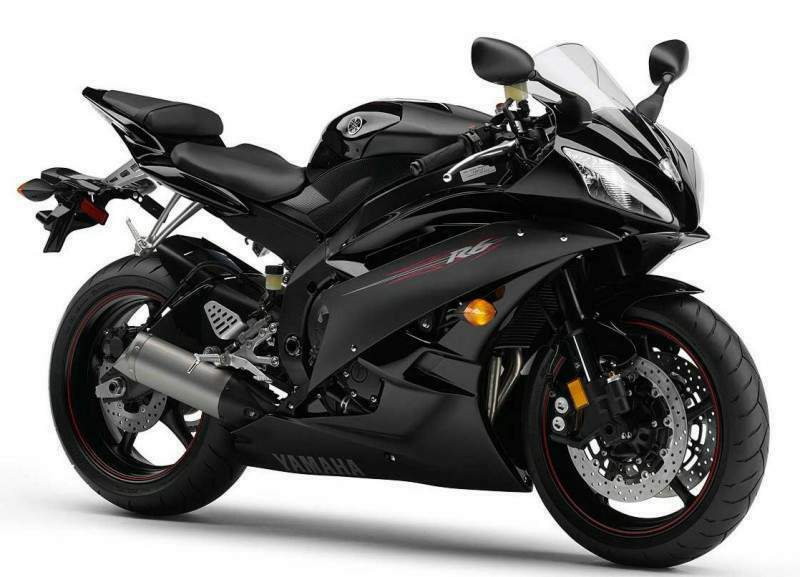
Review
Yamaha�s YZF-R6 has been a major player in the middleweight sportbike wars ever since it debuted in 1999. Combining light weight with razor-sharp handling and a wailing top-end punch, Yammie�s 600cc screamer has been a potent tool that perennially competes for top honors in its class.Then in 2006, the R6 received a ground-up overhaul that resulted in a package that many judged to be the tastiest eye-candy in the segment. That (plus an optimistic 17,500-rpm tachometer) garnered plenty of attention among consumers and the media alike. This flash and controversy somewhat overshadowed a stellar chassis and the bike�s less-streetable character from its racy ergos and the engine�s top-heavy powerband.
So in this mid-cycle revision for �08, the tweaked R6 has a bolstered midrange punch and even better handling dynamics in the face of new-for-2007 challengers from Honda and Kawasaki, plus a revised GSX-R600 from Suzuki for �08. Yamaha invited Motorcycle.com to the hills and twists of Laguna Seca near Monterey, California, so we could gleefully sample the latest iteration of this sportbike sales success: R6 sales are up 44% since 2001.
This is a critical class for all manufacturers of sportbikes. The 600cc segment makes up 51% of what Yamaha calls the Supersport market, a segment that is up in sales a huge 52% since 2001.
The key change to this new R6 is an engine that is architecturally the same but has received some 50 refinements to improve how it delivers its power. Working in conjunction with the bike�s existing YCC-T ride-by-wire throttle is another techie acronym we first saw in last year�s R1: YCC-I, which is a variable-length intake trumpet stack called Yamaha Chip Controlled Intake. At lower revs, the intake air is fed with the fuel-injection�s velocity stacks in their long configuration for enhanced torque output. But the system electronically converts to a short intake tract at 13,700 rpm for optimum performance at the top-end.
Yamaha showed us a dyno-chart comparison of this new model against last year�s that demonstrate a stronger midrange plus even more power up top. Although the chart didn�t have numbers on it that show exactly the parameters of the power comparison, the curve of the new bike was clearly stouter in the upper midrange. Peak torque now arrives 1000 revs sooner at 10,500 rpm. And at the upper end, a Yamaha rep revealed to Motorcycle.com that horsepower at the rear wheel handily exceeds 110.
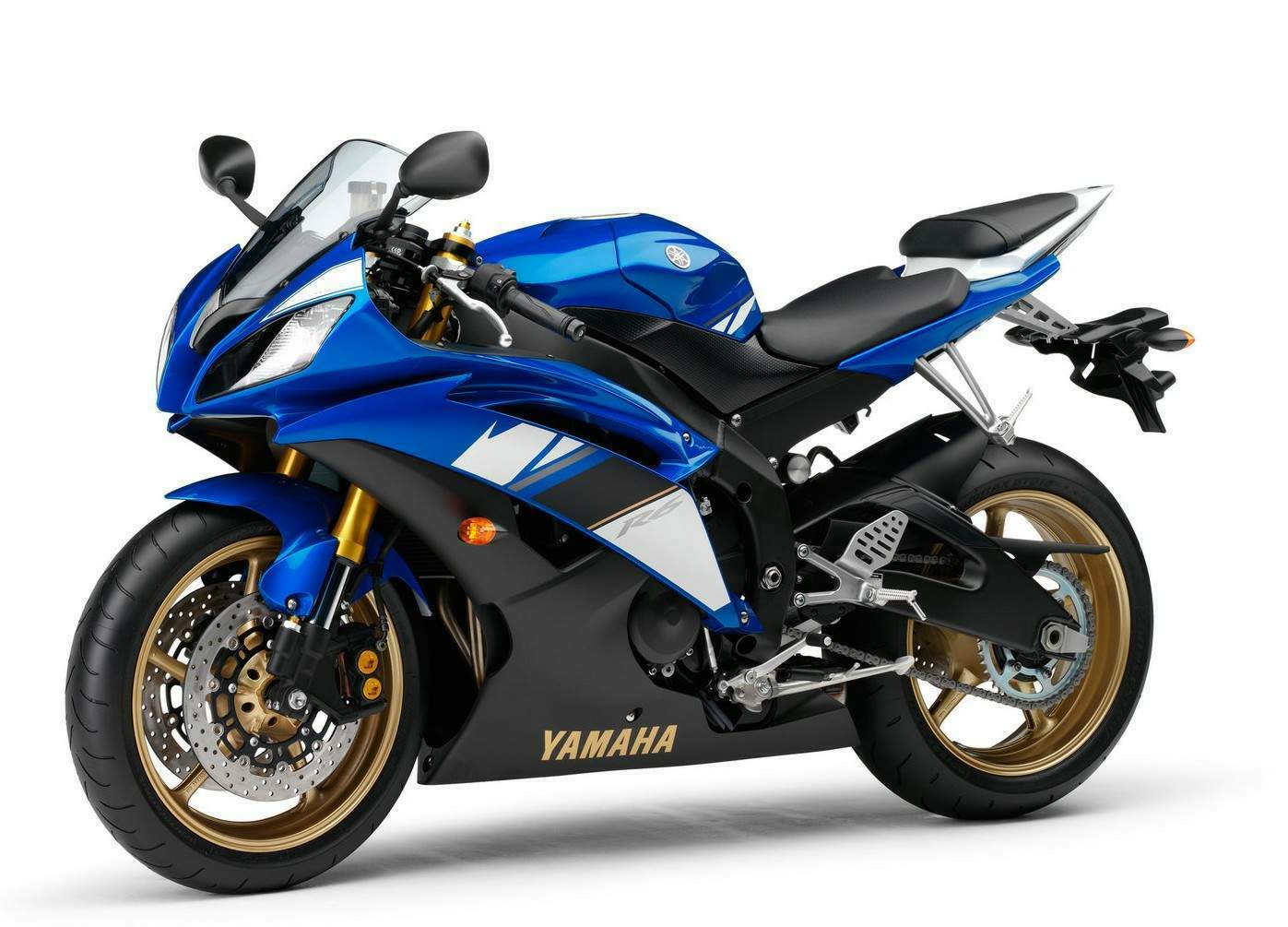
Rocketing out of Laguna�s Turn 11 and onto the front straight reveals seat-of-the-pants impressions that back up the dyno chart, although the R6 still can�t be described as torquey. As before, strong power arrives only once past 10,000 rpm, but now the hit is superior in its quality and quantity. From that point, there�s a 6000-rpm strata of ripping high-end power that is a joy to crank up around a racetrack. As long as you use the excellent gearbox to keep the engine in this bountiful range, the R6 will be hard to catch by any other middleweight.
To achieve this augmented powerband, Yamaha engineers made several other modifications to the 599cc powerplant in addition to the YCC-I. A bump in compression from 12.8:1 to 13.1:1 aids torque production, as do 83% larger crossover pipes in the exhaust headers. Cam timing was subtly altered to augment the new engine tuning. Meanwhile, several tweaks to reduce internal friction free up more ponies in the upper range, and wider connecting-rod bearing increase durability. The MotoGP-inspired snub-nosed exhaust retains its titanium construction and powerband-enhancing EXUP valve.
The changes to this year�s R6 go much further than the engine room. Yamaha�s testing guy Mike Ulrich stated in his presentation that it�s �a brand-new bike from the tires up.� While the chassis�s geometry remains unchanged (24.0-degrees rake; 3.8 inches of trail; and a 54.3-inch wheelbase), the cast-aluminum frame has received a major overhaul. In the quest for the optimum balance between rigidity and flex to achieve the finest feedback to the rider, a crossmember was removed from between the frame rails which are now thicker and stronger. The net result is incrementally increased flexibility in all three axes.
It probably helped that the R6�s senior project engineer, Kouichi Amano, comes from an extensive testing background and can haul ass around a racetrack. �The concept is razor-sharp handling,� the gracious Japanese engineer told Motorcycle.com, �and front-end feedback is more better than current R6. This model is more for track riding, so we made it sharper handling.�
Amano and his team also made revisions to the R6�s aluminum swingarm, adding some internal ribbing and replacing an extruded-aluminum section with a new forged piece for less overall flex. The R6�s aluminum subframe is replaced by a magnesium casting in a first for a large-scale production bike, with a weight saving of 1 lb in a critical area for attaining best mass-centralization.Yamaha research shared during the R6�s presentation revealed that annual track miles for the 600cc Supersport class have gone up 42% from 2004 to 2006; for the R6 in particular, track usage is up an incredible 86%. As such, Yamaha has fitted slightly stiffer springs in the front and rear suspension of the new R6 to keep it taut under the rigors of track abuse. And to retain the proper steering geometry when spooning on larger-diameter rear race rubber, Yamaha has thoughtfully endowed the new R6 with greater attitude adjustments in the form of longer fork tubes and a rear ride-height adjuster � with some race rubber, last year�s bike required the fork tubes to be positioned below flush in the upper triple clamp.
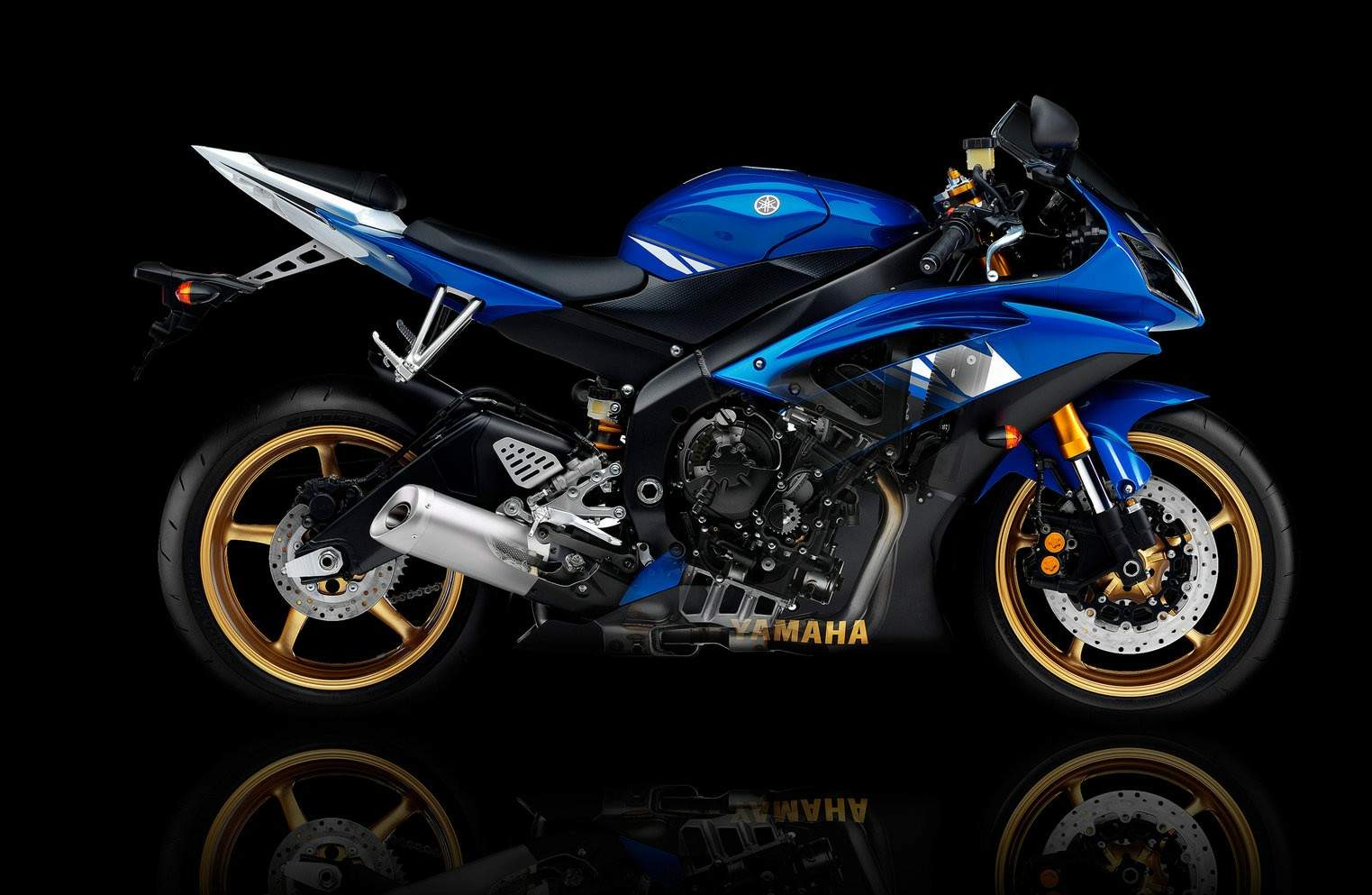
Adjusting ride heights at Laguna Seca wasn�t an issue, as we would be riding on the bike�s stock Dunlop Qualifiers. A �PTM� designation indicates a tire developed specifically for the R6, with a slightly more pliable sidewall. These Qualifiers didn�t immediately endear them to the assemblage of journalists, as cold track temperatures conspired to keep grip levels low. Further holding back my confidence in my first session were suspension settings that were too stiff for my scrawny little frame, which weren�t allowing the tires to be worked hard enough.
It performed so well that I couldn�t imagine a change that would improve it...
The astute Ulrich took a step of spring preload out of both ends of my bike and reduced the fork�s new high-speed compression damping circuit. The result was a bike that now responded perfectly. A slight increase in front-end dive made the front tire dig in harder, and turn-in response that was initially reluctant became easier. I also noted an increase in rear-end grip, and soon the tires were scuffed all the way to their edges. With these settings, the R6 responded kindly to pavement imperfections and felt much more composed. It performed so well that I couldn�t imagine a change that would improve it, so the eager wrenches in the pits sat idle for the rest of the day.With the setup dialed in, I could now concentrate on the nuances of how the R6 performed while re-learning a track I hadn�t ridden on in more than three years. Despite having been repaved twice in the past two years, the track surface has a few chewed-up spots in a couple of corners, but the more compliant suspension happily shrugged them off. Feedback from the bike was plentiful, and I�d rate it improved over the previous iteration�s admirable chassis communication. Several of the motojournalists in attendance reported front-end slides as the tires struggled early with grip, but not one rider had a rubber-side-up result all day. (We can�t say the same about another web-zine�s �daily� author on the previous day�)
The aspect of the bike�s performance most appreciated is the revised engine�s flawless throttle response. I experienced none of the digital-feeling abruptness common among many fuel-injection systems, either while coming back on the throttle or while closing it when slowing for corners. Yamaha has cleverly modified the new EFI to allow some fuel to continue to flow through the throttle bodies under trailing-throttle conditions. This, combined with a mostly excellent slipper clutch, removes harshness from the driveline during corner entries, allowing a rider to focus on brake modulation while getting the bike adequately slowed.
When it comes to brakes, the old R6 wasn�t really lacking. It already enjoyed the benefits of features like radial-mount one-piece calipers, a radial-pump master cylinder and generously sized 310mm front rotors. For �08, the twin discs up front have been widened by a half millimeter to 5.0mm for additional heat-shedding properties, and it�s hard to imagine a better combination of power and feel from a set of binders in this class. The bike�s slipper clutch is unchanged, and it proved flawless when banging down a couple of gears for Laguna�s Turn 2 Andretti Hairpin or the positive-camber Turn 5. A slightly harsh downshift was revealed only into the first-gear Turn 11 that precedes the track�s front straight.
By the time the Turn 1 crest in the road has your butt flying off the seat, an R6 rider is almost all the way through fourth gear. I predict the R6�s upper-range power is superior to all its class rivals, and on the racetrack, it�s easy to keep the shrieking, rev-happy mill on the boil. Only racers or Group A trackday riders will require more Ground Clearance than what�s offered with the R6�s footpeg feelers removed, offering a claimed 57-degree lean angle.
As for how the bike might perform on the street, we can only estimate, as all our time on the pre-production bikes was spent on the 2.2-mile racetrack. However, clip-on handlebars that were already quite low have been lowered a further 5mm (they are also 5mm further forward, but so is the seat), which won�t be appreciated during long slogs on the street. And the limited amount of time we spent with the tach below 10,000 rpm did expose that the R6 still has a way to go to match the amazingly punchy CBR600RR.
One thing that won�t hold back the R6 for street riders is its creatively distinct styling that has made it a class favorite. Bodywork looks very similar but is all new, with a slightly more aerodynamic appearance. Its arresting stealth-fighter edginess remains. The most stylistically appealing bit is a new tailsection that is thinner when looked at in profile. It�s a bit wider across the beam, and it incorporates a few new interesting facets. The rider�s wide seat remains unchanged.
One part of the spec chart Yamaha neglected to shine a light on was the bike�s claimed dry weight. At 366 pounds devoid of all fluids, it�s 9 lbs heavier than claimed for �07. And that�s despite the lightweight magnesium used for the engine covers and new subframe. It seems as if blame must fall on the additional complexity of YCC-I, longer fork tubes, the beefed-up chassis and the thicker brake rotors.
Pricing is in line with the R6�s weight: up incrementally. The three main color choices of the black Raven (with sponsorship decals), Team Yamaha Blue and new Liquid Silver have an MSRP of $9,599 and will be in dealers soon. For those who need a bit more bling, you might want to wait an extra month for the $9,799 Cadmium Yellow version with flames to arrive in showrooms.
The 2006/2007 R6 was revered for its radical styling and sharp handling, but its relative lack of midrange grunt made it less desirable for typical streetbike use. This new iteration is better in most every conceivable way, but it remains saddled with a racer-oriented design. The bulk of its engine output is still in the upper ranges, the handlebars put more pressure on a rider�s wrists, there�s not a lot of wind protection from the fairing, and the seat height is among the tallest in the class.
But for all those R6 riders who take their bikes to the track, it�s hard to imagine a better tool for learning to go faster while giggling like a schoolboy inside your helmet. In this environment, there might not be a better choice than the eager R6 and the operatic soundtrack as it shrieks to its 16,500-rpm redline.
Is this �08 version good enough to command an extra 300 bucks? You betcha!
Source Motorcycle.com
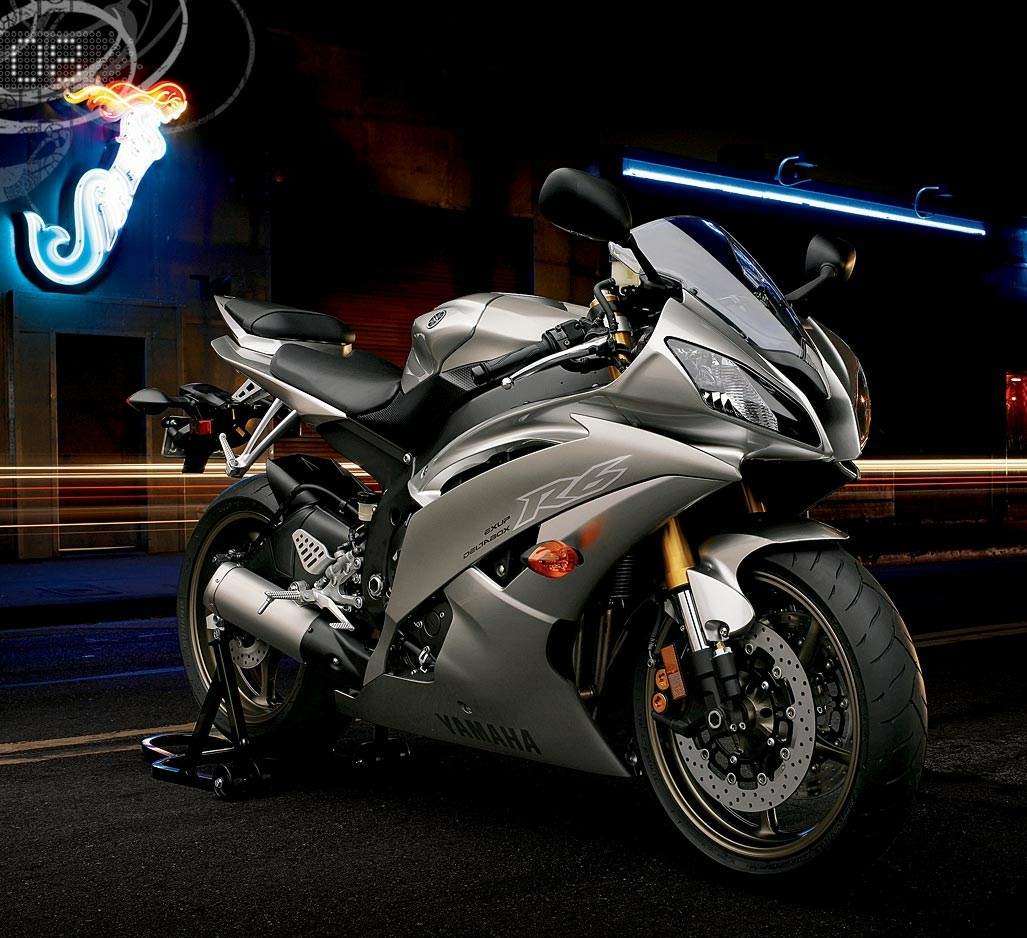
Source: https://www.motorcyclespecs.co.za/model/yamaha/yamaha_r6%2008.htm
